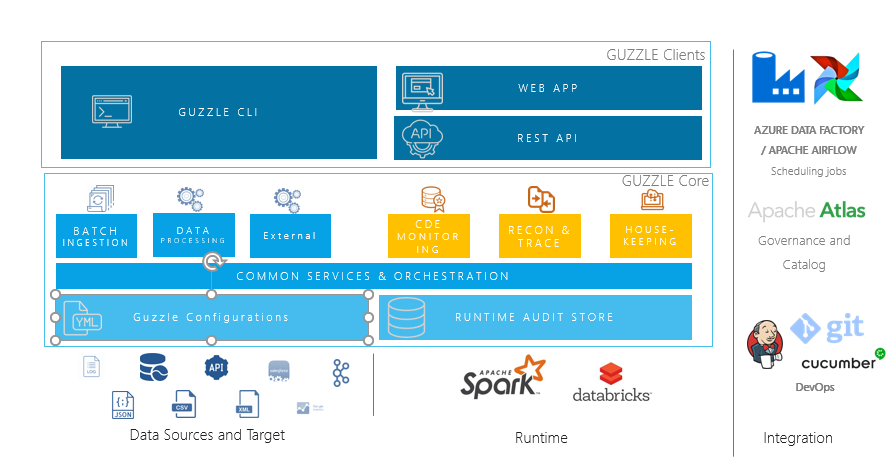What is Guzzle
Guzzle enables analytics engineers to build data pipelines consisting of extraction, transformation, loading, validation and reconciliation for their data warehouses and data lakes by specifying a set of simple configurations. As Guzzle user, you remain focused on specifying high level configurations settings and business logic for data pipelines, and let Guzzle handle the low level implementation details for you.
Built on the foundation of Apache Spark, Guzzle leverages the Spark connectors to extract and load data at massive scale on most common datastores (both relational data warehouses or data lakes). All the transformation and validation rules in Guzzle are specified in SQL, lingua franca of the data.
Guzzle is available on
- Azure Marketplace and gets deployed as virtual machine. It supports Azure Databricks, Azure synapse spark pool or bundled local spark in Guzzle VM. Refer to Deploying Guzzle on Azure for the details of setting up Guzzle instance.
- AWS Marketplace and gets deployed as EC2 instance. It supports AWS EMR EC2, AWS EMR Serverless, AWS Glue, AWS Databricks and bundled local spark in Guzzle. Refer to Deploying Guzzle on AWS for how to set up Guzzle in AWS.
What makes Guzzle powerful?#
Guzzle is a Data Engineering Workbench that automates the movement and transformation of data. It allows the creation, deployment, and monitoring of data pipelines which consist of ingestion, processing, reconciliation, data quality and house-keeping activities.
Native to Apache Spark and big data
Simple to deploy and use
Encapsulate commonly occurring design patterns in the data pipelines
Supports of wide array of source and target technology
Detail traceability and provenance of job runs
Deeper support for DevOps — out of box integration with Git (and git workflows), test-automation and auto-deployment
What are the building blocks of Guzzle?#
Activities: These are individual data integration tasks meant to either
ingest data
process the data (processing logic defined as SQL)
perform reconciliation of data between any two tables/SQL across same or different datastores
do constraint (data quality) checks of your data in a standard way
house keep any historical data
Pipelines: You can combine activities to form pipelines, to either run them sequentially or in parallel with Guzzle automatically determining the dependencies between them
Batches: Pipelines can optionally be combined as batches which provides advanced orchestration capabilities of running them in sequence (or stages), and ability to run catch-ups by sequence of date or time interval
Datastores: These represent connections to the databases, cloud storage and REST URI
Computes: These are the Apache Spark environment that will run the activities and carry out actual data ingestion, processing, reconciliation and other tasks
Schedules : A schedule enables you to run one or more activities, pipeline or batches either sequentially or concurrently at a specific interval
Collectively all the above buildings blocks are referred to as Configs which gets stored as YML files. Also, activities, pipelines and batches are specifically referred to as jobs as they are executables and can be individually run.
What is the typical Workflow of using?#
A analytics engineer logs in to Guzzle UI and defines the datastores, activities and compute
Additional to this, they can define pipelines or batches to orchestrate multiple activities.
Finally, they will run these activities interactively from UI, schedule it using Guzzle schedule feature or invoke it from external scheduler using Guzzle REST API
User can monitor the job runs from Guzzle Monitor UI or via Guzzle REST API
Architecture Overview of Guzzle#
Guzzle architecture consist of following components:
Configs: These are YML based configuration files that capture the definition of activities, pipelines, batches, datastores, compute and schedules.
Guzzle binaries : These are core binaries of Guzzle which perform specific task of ingesting data, processing, reconciliation, etc.
Guzzle App: This consist of Guzzle REST API and Web app which allows users to author Guzzle configs, Run and monitor jobs, and administer Guzzle environment configurations
Repository database : This stores run-time audits of job runs, output of reconciliation, data quality checks and housekeeping, watermark values for incremental data load and other metadata for Guzzle app
